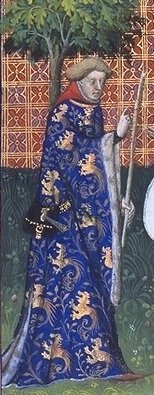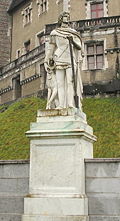
Gaston III of Foix-Béarn
Encyclopedia

Béarn
Béarn is one of the traditional provinces of France, located in the Pyrenees mountains and in the plain at their feet, in southwest France. Along with the three Basque provinces of Soule, Lower Navarre, and Labourd, the principality of Bidache, as well as small parts of Gascony, it forms in the...
(1343–1391). Officially, he was Gaston III of Foix and Gaston X of Béarn.
Early life
He was born in OrthezOrthez
Orthez is a commune in the Pyrénées-Atlantiques department in south-western France.It lies 40 km NW of Pau on the Southern railway to Bayonne. The town also encompasses the small village of Sainte-Suzanne thus residents of the town are called either Orthéziens or Sainte-Suzannais...
, the son of Gaston II/IX (1308–1343).
Count of Foix
Béarn had passed to the county of Foix in 1290. Count Gaston III Fébus paid homage to the king for his own county, but refused to give homage for Béarn, which he claimed as an independent fief, with its chief seat his stronghold at Pau, a site that had been fortified by the 11th century, which was later made the official capital of Béarn Province in 1464.He was succeeded as count of Foix by Mathieu of Foix-Castelbon.
A fortune won in battle
The house of Béarn-Foix was engaged in a long running feud with the family of D'ArmagnacHouse of Armagnac
The House of Armagnac, at the end of the thirteenth century, was not yet powerful enough to play a political role beyond its possessions. The House of Toulouse, which ruled over the large southwest of France, was defeated by the Capetians during the Albigensian Crusade, but local dynasties, like...
. In 1362, a battle was fought between the two sides at Launac
Battle of Launac
The Battle of Launac took place on 5th December, 1362. It was the culmination of a long running feud between the French aristocratic families of D'Armagnac and Foix-Béarn. The chief protagonists were Jean, Comte d'Armagnac and Gaston Fébus of Foix...
. Gaston Fébus was victorious and succeeded in capturing his chief rivals, whom he ransomed for a vast fortune of at least 600,000 florins. This money was stored in the Moncade tower in Orthez
Orthez
Orthez is a commune in the Pyrénées-Atlantiques department in south-western France.It lies 40 km NW of Pau on the Southern railway to Bayonne. The town also encompasses the small village of Sainte-Suzanne thus residents of the town are called either Orthéziens or Sainte-Suzannais...
, where Fébus also created a gallery of portraits and military trophies to commemorate the event.
Records of Jean Froissart
In the 1380s, Jean FroissartJean Froissart
Jean Froissart , often referred to in English as John Froissart, was one of the most important chroniclers of medieval France. For centuries, Froissart's Chronicles have been recognized as the chief expression of the chivalric revival of the 14th century Kingdom of England and France...
visited the County of Foix
County of Foix
The County of Foix was an independent medieval fief in southern France, and later a province of France, whose territory corresponded roughly the eastern part of the modern département of Ariège ....
. He recorded the splendor of the court of Orthez under Gaston Fébus in the latter half of the 14th century. Gaston recorded the three "special delights" of his life as "arms, love and hunting"; he wrote an important treatise on the latter entitled Livre de chasse.
Livre de chasse (Book of the Hunt)
Gaston was one of the greatest huntsmen of his day, and hunted literally to his dying day - he died of a stroke as he was washing his hands after returning from a bear hunt. His Livre de chasse was written between 1387 and 1388. It was dedicated to Philip the BoldPhilip the Bold
Philip the Bold , also Philip II, Duke of Burgundy , was the fourth and youngest son of King John II of France and his wife, Bonne of Luxembourg. By his marriage to Margaret III, Countess of Flanders, he also became Count Philip II of Flanders, Count Philip IV of Artois and Count-Palatine Philip IV...
, Duke of Burgundy
Duchy of Burgundy
The Duchy of Burgundy , was heir to an ancient and prestigious reputation and a large division of the lands of the Second Kingdom of Burgundy and in its own right was one of the geographically larger ducal territories in the emergence of Early Modern Europe from Medieval Europe.Even in that...
. Recorded in the book are different stages of hunting and hunting different animals. The book also describes animal behavior, offers advice to poor gentry how they may enjoy hunting without bankrupting themselves, and is even sympathetic to the peasant poacher because he too has the hunting instinct.
It is the classic treatise on Medieval hunting
Medieval hunting
Throughout Western Europe in the Middle Ages, men hunted wild animals. While game was at times an important source of food, it was rarely the principal source of nutrition. Hunting was engaged by all classes, but by the High Middle Ages, the necessity of hunting was transformed into a stylized...
, and noted for one manuscript which has exquisite miniatures, illustrating the hunt.
Marriage and children
Gaston Phoebus married Agnes of Navarre (1334–1396), daughter of Joan II of NavarreJoan II of Navarre
Joan II was Queen of Navarre from 1328 until her death. She was the only daughter of Margaret of Burgundy, first wife of King Louis X of France...
and Philip III of Navarre
Philip III of Navarre
Philip III , called the Noble or the Wise, Count of Évreux and King of Navarre , was the second son of Louis of Évreux and Margaret of Artois and therefore a grandson of King Philip III of France...
in 1348. They had a son:
- Gaston ( -1382), married Béatrice d'Armagnac 1362-1410
Betrayal of the Count's son

Jean Froissart
Jean Froissart , often referred to in English as John Froissart, was one of the most important chroniclers of medieval France. For centuries, Froissart's Chronicles have been recognized as the chief expression of the chivalric revival of the 14th century Kingdom of England and France...
recorded, Gaston Phoebus's son Gaston betrayed him. Gaston tried to poison his father using a powder that he got from King Charles II of Navarre
Charles II of Navarre
Charles II , called "Charles the Bad", was King of Navarre 1349-1387 and Count of Évreux 1343-1387....
. Gaston was caught and imprisoned by his father. Later on, Gaston was accidentally stabbed and killed by his father during a quarrel. After Gaston died, Gaston Phoebus had no legitimate heir. In 1393, in Paris at a masquerade given by the Queen of France, Isabeau of Bavaria
Isabeau of Bavaria
Isabeau of Bavaria was Queen consort of France as spouse of King Charles VI of France, a member of the Valois Dynasty...
, one of Gaston Phoebus's four recorded illegitimate sons, Yvain de Foix, was burned to death when his costume caught fire from a torch. The other performers died as well. This masquerade came to be known as the Bal des Ardents
Bal des Ardents
The Bal des Ardents was an incident that occurred on 28 January 1393 when the French king Charles VI of France was almost killed and four members of the French nobility burned to death while at a celebratory dance held by the Queen, for the remarriage of a lady-in-waiting, the dancers were...
.
See also
- Se Canta, an Occitan song attributed to Gaston Fébus.
- Castle of FoixChâteau de FoixThe Château de Foix is a castle which dominates the town of Foix in the French département of Ariège. An important tourist site, it is known as a centre of the Cathars. It has been listed as a monument historique by the French Ministry of Culture....
- Counts of FoixCounts of FoixThe counts of Foix ruled the independent County of Foix, in what is now southern France, during the Middle Ages. Later they extended their power to almost the entire Pyrenees mountain range, moving their court to Pau, in Béarn, until eventually the last count of Foix acceded to the French throne as...
- AndorraAndorraAndorra , officially the Principality of Andorra , also called the Principality of the Valleys of Andorra, , is a small landlocked country in southwestern Europe, located in the eastern Pyrenees mountains and bordered by Spain and France. It is the sixth smallest nation in Europe having an area of...
- Château de MauvezinChâteau de MauvezinThe Château de Mauvezin is a castle in the commune of Mauvezin in the Hautes-Pyrénées département of France.The site, occupied since protohistory, was transformed into a castrum in the Middle Ages and later into a castle. The castle was built by Gaston Fébus around 1380...

